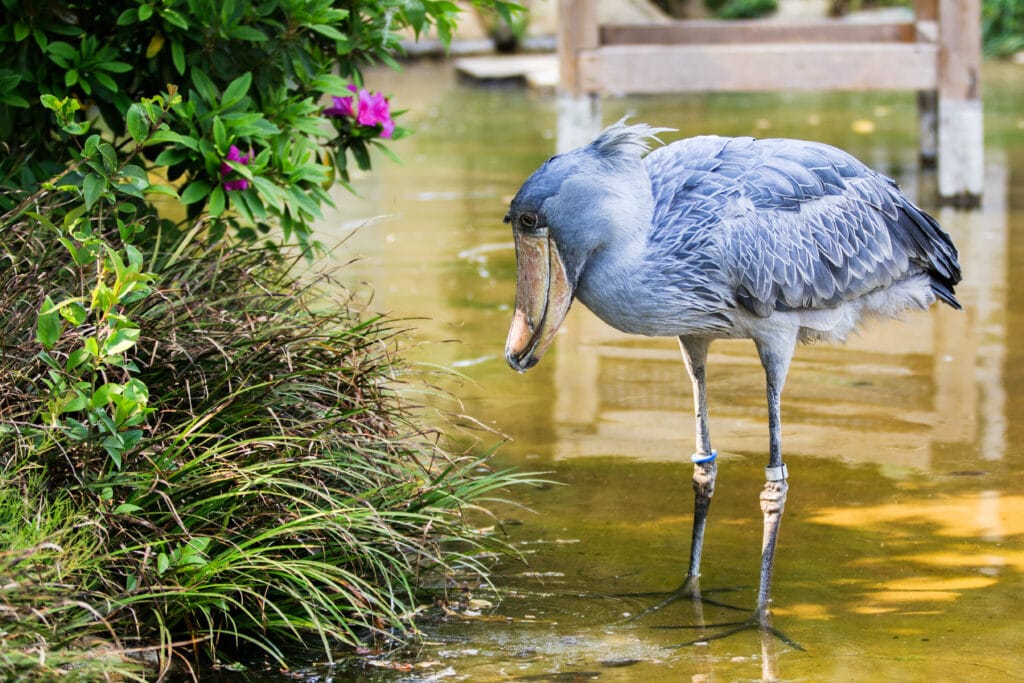What looks like a Muppet and sounds like a jackhammer? Why it’s the Shoebill Stork, of course! These tall wading birds are instantly recognized for their unique appearance. Long elegant legs allow the Shoebill Stork to reach up to five feet tall. The most distinctive feature of the Shoebill Stork is its namesake bill. Named for its resemblance to a clog, the bill of the Shoebill Stork is wide and curved, with a unique shape that doesn’t quite match up with the bills of any other birds. Because of this bill, Shoebills are sometimes called “Whale-bills” or “Whale-headed Storks.”
Shoebill Storks are wetlands birds. They live in marshy regions of Central Africa and are often seen standing stock-still in the water. This is because they are ambush hunters. Like many other wading birds, Shoebill Storks employ a patient method of hunting wherein they carefully watch the water for fish, frogs, lizards, and other prey animals. Because they are so still, their prey comes close and the Shoebill Stork springs into action, falling onto its prey and using its impressive bill to scoop up its dinner.
Related Article: Flamingo Sightings Throughout the Southeast After Hurricane Idalia
Fun Facts About the Shoebill Stork
Shoebills don’t just look unique. They’ve also got unique personalities and behaviors that make them stand out from even their closest relatives. Let’s dive into some fascinating Shoebill fun facts!
- Shoebill Stork romance is complicated: Shoebill Storks might not look as romantic as swans, but they do form long-lasting monogamous pairs. But the ideal Shoebill relationship involves some healthy boundaries. Shoebill Storks are fiercely territorial and don’t enjoy sharing their hunting grounds with others. Even monogamous pairs will hunt for food at opposite ends of their territory to avoid stepping on each other’s toes.
- Baby Shoebills hiccup for food: Shoebills are generally quiet birds. They don’t vocalize often, and the noise that they are most known for is actually a bill-clattering sound that they make as a greeting to one another at nest sites. This bill clattering sound is often described as sounding like a machine gun. But baby Shoebill Storks have a special vocalization of their own. When begging their parents for food, Shoebill chicks are said to make a sound that is eerily similar to human hiccups.
- In a league of their own: Once upon a time, Shoebills were thought to belong to the order of the Ciconiiformes. This is the stork family. It’s easy to see why early classification might’ve placed Shoebills in this group, but recent studies suggest that they have much more in common with herons and pelicans. The nearest relative of the Shoebill Stork is the Hamerkop, another taxonomical misfit that has been posited to be related to pelicans. Despite some connections to pelicans, debate continues over whether the Shoebill really belongs in any other group of birds. The family Balaenicipitidae, to which the Shoebill belongs, contains no other living birds.
- An heir and a spare: Shoebills typically produce between one and three eggs per breeding attempt, usually two, but it is rare for more than one to survive to fledge. It is believed that they produce the extra chicks as a sort of insurance policy in case the firstborn is weak or is predated before growing mature enough to fledge.
- Wet and weird: Central Africa’s dry season can be punishingly hot, but despite this, the start of the dry season is usually when Shoebill Stork pairs breed. In order to keep their eggs from frying in the sun, they engage in a strange behavior called “egg-wetting.” Using that large trademark bill, Shoebills scoop up large quantities of water and dump them over their incubating eggs. If plain old water isn’t cutting it, they’ll also cover their eggs with mouthfuls of wet vegetation. Anything to beat the heat!
The Future of the Shoebill Stork
The International Union for Conservation of Nature (IUCN) Red List of Endangered Species lists the Shoebill Stork as both vulnerable and decreasing. According to the IUCN, there are between 3,300 and 5,300 Shoebills remaining in the wild. There are a number of threats that contribute to the precarious position of these unique wading birds, but most of them amount to the loss or degradation of vital wetlands habitats.
Although Shoebills are commonly kept in zoos, they don’t often breed in captivity, so the preservation of wild Shoebill populations is vital to the continuing survival of the species.
Popular Article: Endangered Secretary Bird Hatches in San Antonio

